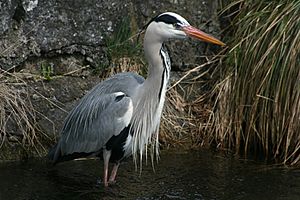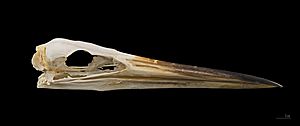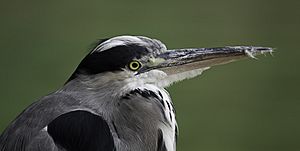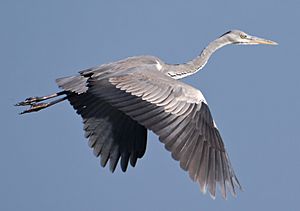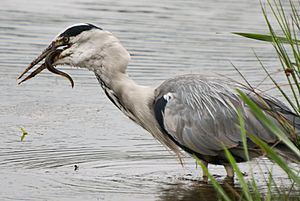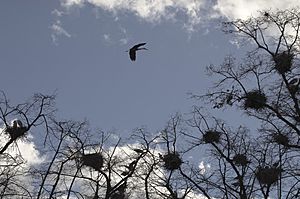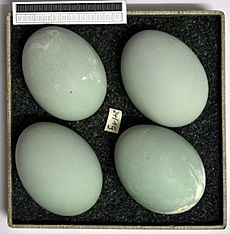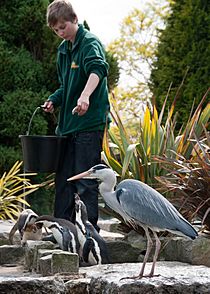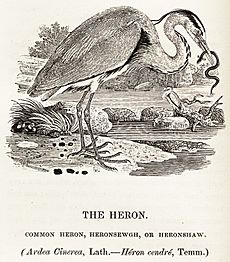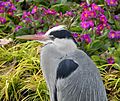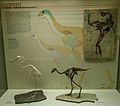Grey Heron facts for kids
Quick facts for kids Grey Heron |
|
|---|---|
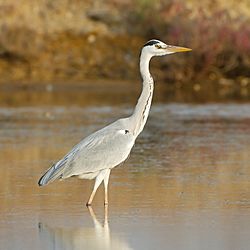 |
|
| Conservation status | |
| Scientific classification | |
| Kingdom: | |
| Phylum: | |
| Class: | |
| Order: | |
| Family: | |
| Genus: |
Ardea
|
| Species: |
A. cinerea
|
| Binomial name | |
| Ardea cinerea Linnaeus, 1758
|
|
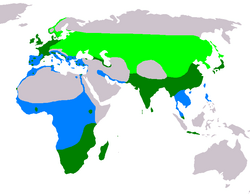 |
|
| Light green: summer Dark green: all year Blue: winter |
|
The Grey Heron is a tall, elegant bird found in many parts of Europe, Asia, and Africa. It has long legs and a sharp beak, which it uses to catch food in shallow water. You can often spot these birds standing still, waiting patiently for a fish or frog to swim by. Its scientific name is Ardea cinerea.
Contents
What Does a Grey Heron Look Like?
The Grey Heron is a large bird. It can stand up to 100 cm (39 in) tall. Its body is about 84 to 102 cm (33 to 40 in) long, and its wings can spread out from 155 to 195 cm (61 to 77 in). These birds usually weigh between 1.02 and 2.08 kg (2.25 and 4.59 lb).
Their feathers are mostly grey on top and greyish-white underneath. Adult herons have a white head and neck with a wide black stripe above their eyes. This stripe ends in a long, thin crest of feathers. They also have bluish-black streaks on the front of their neck. Young herons look a bit duller. They have a grey head and neck, and a small, dark grey crest. The beak is long, straight, and strong, usually pinkish-yellow. It gets brighter in color when they are ready to breed. Their eyes are yellow, and their legs are very long and brown.
Grey Herons make a loud, croaking "fraaank" sound. They also make other noisy sounds, especially when they are nesting. Males use a special call to attract a female to their nest. Both male and female herons use different sounds to greet each other once they are a pair. A harsh "schaah" sound is used by males to warn other birds away from their nest. A soft "gogogo" sound means they are worried, like when a predator is nearby. Baby herons make loud chattering or ticking noises.
Where Do Grey Herons Live?
Grey Herons live across a very large area, mostly in Europe and Asia. They are found as far north as Norway and Sweden, and as far east as the Ural Mountains. To the south, they live in places like Spain, France, Italy, India, and Myanmar. They also live in parts of Africa, including south of the Sahara Desert, the Canary Islands, and Morocco.
Many Grey Herons stay in the same place all year. However, birds from colder northern areas of Europe fly south for the winter. Some stay in central and southern Europe, while others travel all the way to Africa.
Grey Herons can be found anywhere there is water that is shallow enough for them to wade in. This includes lakes, rivers, marshes, ponds, ditches, and even coastal areas. They prefer low-lying areas but can also be seen in mountain lakes. Sometimes, they hunt for food away from water, in grassy fields. They have even been seen in deserts, looking for beetles and lizards. Their nesting colonies are usually close to where they feed.
How Grey Herons Behave
Grey Herons fly slowly with their long necks pulled back in an S-shape. This is a special way of flying that helps you tell them apart from other large birds like storks, which fly with their necks stretched out. They flap their wings slowly and sometimes glide for short distances. They can also soar high in the sky, circling around. Herons often perch in trees, but they spend a lot of time on the ground. They walk slowly or stand very still for a long time, often on one leg.
What Grey Herons Eat and How They Hunt
Grey Herons eat fish, amphibians (like frogs), small mammals (like mice), and insects. They catch these in shallow water using their long, sharp beak. They have also been seen catching and killing young birds, such as ducklings. Sometimes, they even catch birds as big as a water rail.
A heron might stand perfectly still in shallow water, or on a rock, waiting for prey to come close. Then, it strikes very quickly with its beak. Another way they hunt is by moving slowly and quietly through the water. Their body is less upright, and their neck is curved in an "S" shape, ready to strike.
Small fish are swallowed headfirst. Larger prey, like eels, are carried to the shore. The heron might beat them on the ground or stab them with its beak to kill them. Then, it swallows them whole or tears off pieces of meat. For birds like ducklings, the heron holds them by the neck and either suffocates them or snaps their neck before swallowing them whole. Herons spit out indigestible parts of their food, like fur, bones, and insect shells, in small pellets. They mostly hunt around dawn and dusk, but they can be active at other times too. At night, they rest in trees or on cliffs, often in groups.
The Life Cycle of a Grey Heron
Grey Herons build their nests in groups called heronries. These are usually in tall trees near lakes, the seashore, or other wet areas. Sometimes, they choose other places like low trees, bushes, or even cliff ledges. They use the same nest year after year, adding more material each time. A nest starts as a small platform of sticks but grows into a large, bulky nest over time. It might be lined with smaller twigs or grass. The male heron usually gathers the sticks, while the female builds the nest. They start breeding between February and June.
When a heron arrives at the nest, it performs a greeting ceremony with its partner. Both birds raise and lower their wings and plumes. Sometimes, Grey Heron colonies share nesting sites with other types of herons.
The male heron calls from the nesting spot to attract a female. Once a female arrives, both birds do a "stretching ceremony." They stretch their necks straight up, then pull them back down, bending their legs. They also do a "snapping ceremony," where they stretch their neck forward, lower their head, and snap their beaks together quickly many times. Once they are a pair, they might gently preen each other's feathers.
A female heron usually lays three to five eggs, but sometimes as few as two or as many as seven. The eggs are greenish-blue and have a dull surface. They are about 60 mm (2.4 in) long and 43 mm (1.7 in) wide. Eggs are usually laid every two days. Both parents take turns sitting on the eggs, and incubation lasts about 25 days.
Both parents bring food for the young chicks. At first, the chicks grab the adult's beak and take regurgitated food from it. Later, the adult spits the food into the nest, and the chicks fight over it. The young birds are ready to fly when they are about seven to eight weeks old. Usually, herons have one group of chicks each year, but sometimes they have two.
The oldest recorded Grey Heron lived for 23 years. However, most only live for about five years in the wild. About one-third of young herons survive their first year, as many are caught by predators.
Grey Herons in Cities
Grey Herons can live in cities if there are suitable places for them to find food and nest. In the Netherlands, many Grey Herons have moved into cities over the past few decades. In cities like Amsterdam, they are very common and have adapted well to city life. They still hunt for food, but they also visit street markets and snack bars. Some herons even get food from people who feed them at home or share fish caught by recreational fishermen. Similar behavior has been seen in Ireland. Garden ponds with ornamental fish are very attractive to herons. These ponds can be a good place for young birds to learn how to catch easy prey.
Herons have also been seen visiting water areas in zoos, like those for penguins, otters, pelicans, and seals. They sometimes take food meant for the animals on display.
Who Hunts Grey Herons?
Adult Grey Herons are large birds with strong beaks, so they have few predators. However, their eggs and young chicks are more vulnerable. Adult herons usually stay at the nest to protect their young. But sometimes, crows or kites might try to trick them away from the nest. One dead Grey Heron found in the Pyrenees mountains was thought to have been killed by an otter. This heron might have been weak from harsh winter weather, which made it hard to find food.
Grey Herons in Human Culture
In Ancient Egypt, the bird deity Bennu, linked to the sun and creation, was shown as a heron in artwork.
In Ancient Rome, people believed the heron's call could predict future events, just like the calls of ravens or owls.
Long ago in Britain, roasted heron was a special dish served at important events like banquets. For example, at a large feast in 1465, four hundred herons were served! Young herons were still being hunted and eaten in some parts of England as late as 1896. You can see two Grey Herons in a stained glass window in a church in Selborne, Hampshire, England.
Some English surnames like Earnshaw, Hernshaw, Herne, and Heron come from the word "heron." The part "-shaw" means a wood, referring to a place where herons nested.
Images for kids
-
Grey Heron and Caudipteryx skeletons.
-
A Grey Heron eating a juvenile common moorhen.
-
An East German postal stamp from 1959 featuring a Grey Heron.
See also
 In Spanish: Garza real para niños
In Spanish: Garza real para niños



